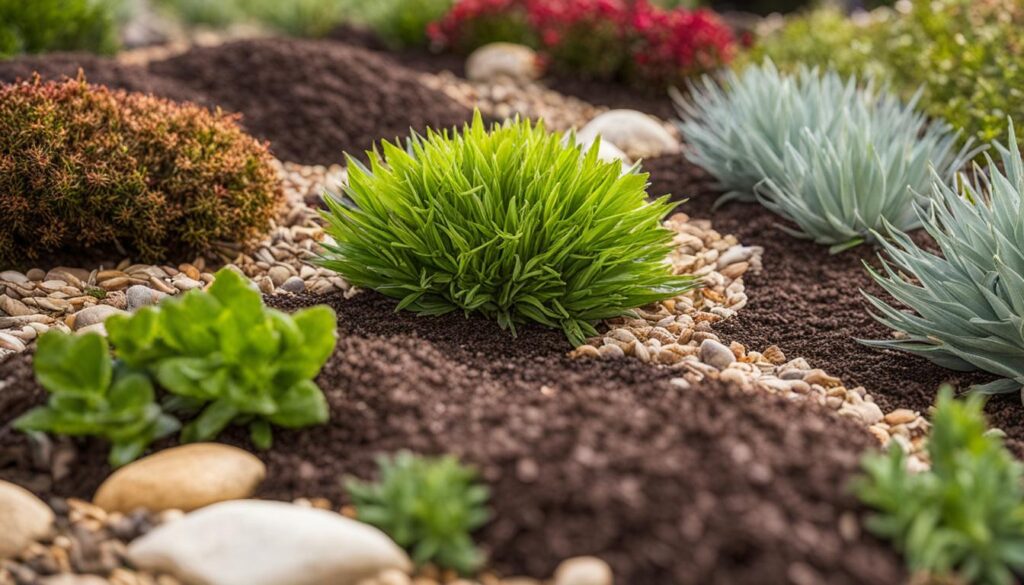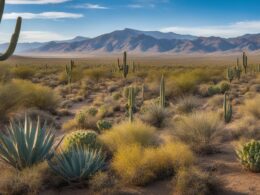Xeriscaping is a landscaping technique that aims to conserve water while maintaining a beautiful garden. One effective way to achieve water savings in xeriscapes is by using mulches. Mulches not only help to retain moisture in the soil but also reduce the need for watering and promote plant health. According to experts, organic mulches such as grass clippings, pine needles, and bark, when spread around the base of plants to a depth of three to four inches, can significantly reduce water evaporation and suppress weed growth. Inorganic mulches, such as lava rock and crushed coral, provide a stylish and low-maintenance option for xeriscapes.
Key Takeaways:
- Water-saving mulches are essential for conserving water in xeriscapes.
- Organic mulches like grass clippings and pine needles retain moisture and suppress weeds.
- Inorganic mulches like lava rock offer a low-maintenance option for xeriscapes.
- Proper mulch placement and integration with efficient irrigation systems enhance water conservation and plant health.
- Xeriscaping with water-saving mulches contributes to environmental sustainability and long-term plant care.
Benefits of Mulches in Xeriscapes
Mulches offer numerous benefits in xeriscapes. Firstly, they help conserve water by reducing evaporation and ensuring that moisture remains in the soil for longer. This not only saves water but also promotes the overall health and vitality of plants.
“Using mulches can reduce water usage in gardens by up to 50%.”
Additionally, mulches act as a natural weed suppressant, preventing weed growth and reducing the need for manual weeding. This not only saves time and effort but also helps maintain a clean and aesthetically pleasing garden. Furthermore, mulches help regulate soil temperature, keeping it cool in hot weather and preventing the soil from drying out too quickly. This is particularly beneficial for xeriscapes, where water availability may be limited.
“Mulches help keep the soil temperature stable, preventing moisture loss and protecting plants from extreme heat.”
Overall, the use of mulches in xeriscapes contributes to water conservation, reduces maintenance efforts, and promotes plant growth. By creating a barrier between the soil and the air, mulches help retain moisture, allowing plants to thrive even in dry conditions. Additionally, the suppression of weeds reduces competition for resources, ensuring that plants can fully utilize the available water and nutrients. With their ability to regulate soil temperature and conserve water, mulches are an invaluable tool for creating sustainable and beautiful xeriscapes.
The Benefits of Mulches in Xeriscapes:
- Conserves water by reducing evaporation
- Promotes plant health and vitality
- Acts as a natural weed suppressant
- Regulates soil temperature, preventing moisture loss
- Reduces maintenance efforts in xeriscapes
Choosing the Right Mulch for Xeriscapes
When it comes to xeriscapes, selecting the right mulch is crucial for the overall success of your garden. There are two main types of mulches to consider: organic mulches and inorganic mulches.
Organic mulches such as wood chips, grass clippings, and straw are popular choices for xeriscapes. They provide natural, nutrient-rich options that gradually decompose, enriching the soil over time. Organic mulches help retain moisture, regulate soil temperature, and suppress weed growth. Additionally, they improve soil structure and promote the growth of beneficial soil organisms.
Inorganic mulches like rock varieties, including cobblestone and lava rock, offer a more long-lasting and low-maintenance option for xeriscapes. Inorganic mulches do not decompose and require minimal upkeep. They are excellent for areas with high foot traffic or where organic mulches may attract pests. Inorganic mulches can also provide a stylish and decorative element to your xeriscape design.
Ultimately, the choice between organic and inorganic mulches depends on your personal preferences, the specific needs of your plants, and the climate in your area. Consider factors such as aesthetics, maintenance requirements, and the overall sustainability of your xeriscape when making your decision.
What Are the Best Water-Saving Mulches for Xeriscapes?
When it comes to mulching for xeriscapes, some of the best water-saving options include gravel, pine needles, and bark chips. These types of mulch can help retain moisture in the soil, reduce evaporation, and suppress weed growth, making them ideal choices for xeriscaping projects.
Mulching Techniques for Water-Saving Xeriscapes
Implementing water-saving mulches is a key aspect of creating sustainable and efficient xeriscapes. By following proper mulching techniques, you can enhance the water retention capabilities of the soil, reduce weeds, and promote the overall health of your plants. Here are some essential tips to consider:
1. Depth of Mulch
It’s crucial to apply mulch at the recommended depth of three to four inches. This depth provides an adequate barrier against evaporation and helps retain moisture in the soil. Too thin of a layer may not offer sufficient protection, while a thicker layer can lead to issues like excessive moisture retention and root rot. Maintain the ideal depth to maximize the benefits of water conservation and plant health.
2. Mulch Placement
When applying mulch, make sure to spread it in a wide circle around the base of your plants, covering the entire root zone. Avoid piling mulch against the stems or trunks, as this can create a moist environment that may promote disease or pest issues. By maintaining a proper distance between the mulch and plant stems, you can prevent potential problems and ensure optimal plant growth.
3. Integration with Irrigation Systems
Integrating water-saving mulches with efficient irrigation systems can further enhance the effectiveness of your xeriscape garden. Consider using drip irrigation or soaker hoses to deliver water directly to the plant roots, minimizing water waste. This targeted approach ensures that moisture reaches the intended areas, reducing the need for excessive watering and maximizing the benefits of mulching.
By following these mulching techniques, you can conserve water, control weeds, and create a thriving xeriscape garden. Remember to choose the right type of mulch based on your specific needs and preferences, and adjust your mulching practices accordingly. With proper implementation, mulches become a valuable tool in maintaining a sustainable and water-efficient landscape.
Conclusion
Water-saving techniques are an essential aspect of xeriscape landscaping, combining sustainability and effective plant care. By incorporating water-saving mulches into your xeriscape garden, you can achieve both aesthetic beauty and environmental responsibility.
With the help of mulches, you can conserve water by reducing evaporation and ensuring that moisture remains in the soil for longer periods. This promotes plant health and vitality while minimizing the need for excessive watering. Additionally, mulches act as a natural weed suppressant, reducing maintenance efforts and allowing your plants to thrive.
By regulating soil temperature, mulches provide a protective layer that keeps the soil cool during hot weather and prevents rapid drying. This not only benefits your plants but also contributes to water conservation efforts.
Embracing water-saving techniques like mulching in xeriscape landscaping allows you to take an active role in sustainable gardening practices. By conserving water and prioritizing plant care, you can create a beautiful and environmentally-friendly outdoor space that benefits both you and the planet.











